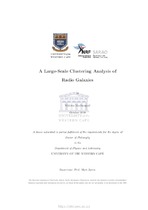| dc.contributor.advisor | Jarvis, Matt | |
| dc.contributor.author | Madhanpall, Nikhita | |
| dc.date.accessioned | 2020-03-16T09:23:51Z | |
| dc.date.available | 2020-03-16T09:23:51Z | |
| dc.date.issued | 2019 | |
| dc.identifier.uri | http://hdl.handle.net/11394/7194 | |
| dc.description | Philosophiae Doctor - PhD | en_US |
| dc.description.abstract | The distribution of the visible structure in the Universe is in part dependent on the
in
uence of the dark matter structure. Measurements of large-scale structure can
therefore be related to the dark matter distribution by calculating the galaxy bias b(z),
which indicates the extent to which the baryonic matter traces out the underlying dark
matter distribution. Radio sources are easily detected out to higher redshifts and are
thus an e ective probe of the large-scale structure of the Universe, however very few
clustering studies have been carried out at sub-mJy levels, as well as for various radio
source types. In this Thesis, I measure the angular two-point correlation function of
radio populations using 11,431 sources from a Jansky Very Large Array (JVLA) CnB
S1:4 > 440 Jy survey over 100deg2 of the Sloan Digital Sky Survey (SDSS) Southern
Equatorial Stripe (Stripe 82), having a resolution of 10 16 arcseconds. | en_US |
| dc.language.iso | en | en_US |
| dc.publisher | University of the Western Cape | en_US |
| dc.subject | Radio galaxies | en_US |
| dc.subject | Measurement | en_US |
| dc.subject | Jansky Very Large Array (JVLA) | en_US |
| dc.subject | Clustering | en_US |
| dc.title | A large-scale clustering analysis of radio galaxies | en_US |
| dc.rights.holder | University of the Western Cape | en_US |

